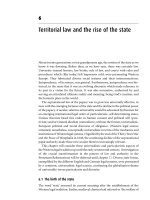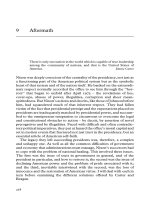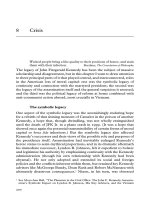The fall and rise of the American petty bourgeoisie
Bạn đang xem bản rút gọn của tài liệu. Xem và tải ngay bản đầy đủ của tài liệu tại đây (110.93 KB, 12 trang )
4. The fall and rise of the American
petty bourgeoisie
200 years ago Thomas Jefferson (1786 [1984: 580]) argued that the
prospect of self-employment justi®ed whatever depredations accompa-
nied indentured service and wage labor: ``So desirous are the poor of
Europe to get to America, where they may better their condition, that,
being unable to pay their passage, they will agree to serve two or three
years on their arrival there, rather than not go. During the time of that
service they are better fed, better clothed, and have lighter labour than
while in Europe. Continuing to work for hire a few years longer, they
buy a farm, marry, and enjoy all the sweets of a domestic society of their
own.'' In the middle of the nineteenth century Abraham Lincoln (1865
[1907: 50]) also saw self-employment as the natural route to individual
prosperity: ``The prudent penniless beginner in the world labors for
wages awhile, saves a surplus with which to buy tools or land for
himself, then labors on his own account another while, and at length
hires a new beginner to help him.'' And even in the waning years of the
twentieth century, in an era of large corporations and powerful govern-
ments, Ronald Reagan (Public Papers of the Presidents of the United
States. Ronald Reagan 1983: 689) extols the virtues of self-employment.
Speaking at the awards ceremony for the National Small Business Person
of the Year, Reagan remarked: ``I am vividly reminded that those shop-
keepers and the druggist and the feed store owner and all of those small
town business men and women made our town work, building our
community, and were also building our nation. In so many ways, you
here today and your colleagues across the country represent America's
pioneer spirit ...Youalso hold the promise of America's future. It's in
your dreams, your aspirations that our future will be molded and
shaped.''
Being one's own boss, being self-employed, is a deeply held ideal in
67
American culture. In the 1980 US class analysis project data, 54% of
people in the American working class, and two-thirds of male workers
say that they would like to be self-employed some day (for detailed
results, see Wright 1997: 115±117). What is more, this ideal is not a
complete fantasy: while, depending upon precise de®nitions and data
sources, only about 8±14% of the labor force in the United States was
self-employed in 1980, 16% of current employees have been self-em-
ployed at some time during their work lives (almost 20% for men),
which means that at least a quarter of the labor force and a third of the
male labor force either is or has been self-employed. If we go back one
generation, about 31% of Americans currently in the labor force come
from families within which the head of the household was mainly self-
employed when they were growing up, and 46% came from families
within which the head of household was self-employed at least part of
the time while they were growing up. Finally, if we ask Americans to
describe the jobs of their three best friends, 31% indicate that at least one
of their friends is self-employed, and 7% are married to someone who is
self-employed. Taking all of these data together, two-thirds of Americans
in the labor force have some direct personal linkage to self-employment,
by being or having been self-employed themselves, by coming from a
family of origin in which the head of household was self-employed, by
having a close friend who is self-employed, or by being married to
someone who is self-employed. What is more, this density of ties to self-
employment varies hardly at all across the different class locations
among employees.
This intermeshing of the lives of the petty bourgeoisie and employees
is not a unique feature of the United States. Roughly comparable ®gures
are found in the other countries in the Comparative Class Analysis
Project. In Sweden, Norway and Canada, about 55% of the labor force
has some direct personal tie to self-employment, while in Japan the
®gure is 68% (mainly because of a much higher level of people who are
currently self-employed). Where the United States does seem to differ
markedly from the other countries is in the aspiration of employees to
become self-employed: nearly 58% of US employees say that they would
like to be self-employed someday, compared to 49% in Canada, 40% in
Sweden, 31% in Japan and only 20% in Norway.
Self-employment is thus a central part of both the ideological and
social fabric of American life. Yet, remarkably, self-employment has
received almost no systematic empirical study by sociologists. When
sociologists study strati®cation, it is rare that self-employment is treated
Class counts68
as a distinct problem. With limited exceptions, the typical class schema
for sociological studies goes from upper white collar to lower blue collar
and farm occupations, with the self-employed being fused with these
categories according to their occupational activities. And, while there are
many studies of small business and of speci®c categories of self-employ-
ment, especially farmers and various kinds of professionals, there is very
little quantitative research on the general problem of self-employment.
The basic objective of this chapter is to analyze the historical trajectory
of self-employment in the United States, particularly in the post-World
War II period. The chapter will revolve around a striking feature of the
time trend in rates of self-employment in the labor force: on the basis of
the best available time series it appears that from the nineteenth century
to the early 1970s there was a virtually monotonic annual decline in the
rate of self-employment in the United States, dropping from around 40%
at the end of the nineteenth century to about 20% in the 1940s and to
under 10% in the early 1970s; from 1973 to 1976 the self-employment rate
was basically stable, but since then there has been a gradual increase in
the rate of self-employment (for detailed time series, see Wright 1997:
119). By the early 1990s, that rate was a full 25% higher than it had been
in the mid-1970s. Similar trends are found in a number of European
countries (Bechhofer and Elliott 1985). What is the explanation for this
dramatic change? Does it re¯ect a response to the relative stagnation in
the American economy from the early 1970s to the early 1990s? Is it an
aspect of the transition to a ``post-industrial'' economy in which a variety
of new kinds of services, often involving relatively little physical capital,
is growing?
These questions are particularly relevant for the concerns of this book
since the rise of self-employment in the last quarter of the twentieth
century runs counter to traditional Marxist expectations of the demise of
the petty bourgeoisie as a result of capitalist development. As noted in
chapter 3, traditional Marxism identi®ed two long-term causal processes
which shape the historical trajectories of the petty bourgeoisie and small
employers. First, there is the inherent tendency for the expansion of
capitalism to destroy all precapitalist forms of economic relations,
including subsistence producers and simple commodity producers.
Second, as capitalism develops, there is a tendency for capitalist units of
accumulation to become larger both relatively and absolutely which
reduces the proportion of small employers in the population.
Taken together, these two causal processes lead Marx and subsequent
Marxists to predict that the Petty Bourgeoisie (understood as small
69The American petty bourgeoisie
employers and the pure petty bourgeoisie combined) would gradually
wither away. Certainly on a broad historical scale, this has been one of
the most robust of Marx's predictions. While rates of change may have
varied, in all developed capitalist countries, there was a steady decline in
self-employment from 40±50% at the end of the nineteenth century to
10±15% or so at the end of the twentieth. Yet, in more recent decades,
this longstanding decline seems to have been arrested and possibly even
reversed. The task of this chapter is to explore why this may have
occurred.
4.1 Self-employment and economic stagnation
One possible explanation for the recent increase in self-employment is
that it is a direct response to cyclical patterns of unemployment. A
certain amount of self-employment is plausibly a response to a lack of
good wage labor employment opportunities. While unemployment
insurance and welfare programs may reduce the incentives for the
unemployed to seek self-employment, one would nevertheless expect
increases in the unemployment rate to generate increases in self-employ-
ment. Given the relative economic stagnation in the American economy
from the early 1970s into the 1980s, it might be the case that the apparent
reversal of the long-term trend in self-employment simply re¯ects
increases in unemployment in the period.
The best way to test this possibility is to estimate time series regression
equations predicting the rate of self-employment and then see if the
effect of time on self-employment changes when we control for the
annual rate of unemployment in the equation. I calculated these regres-
sions in a variety of different ways to be sure that the results were
robust. The results were quite unambiguous: the positive time trend in
self-employment since the early 1970s is signi®cant even when we
control for rate of unemployment (for details see Wright (1997:
127±130)). While long-term stagnation might be a contributing factor, it
seems unlikely to provide the main explanation for this reversal of the
historic decline of the petty bourgeosie.
4.2 Sectoral decomposition of changes in self-employment
Another possible explanation for the reversal of the historical trajectory
of the petty bourgeoisie is that expanding opportunities for self-employ-
ment are in one way or another bound up with the transition to a ``post-
Class counts70
industrial'' society as discussed in chapter 3. One might hypothesize that
the expansion of various kinds of high-tech services opens up greater
possibilities for self-employment, since in many instances these services
require relatively little physical capital.
We will explore in a preliminary way the plausibility of the post-
industrial hypothesis by examining the relationship between changes in
the sectoral composition of the labor force and self-employment using
the same kind of sectoral shift-share decomposition procedure we
adopted in chapter 3.
Figure 4.1 presents the sector-shift components and the class-shift
components for the rates of change of self-employment in each decade
between 1940 and 1990. Two things are especially striking in this ®gure.
First, the sharp, negative class-shift component for self-employment ±
indicating a steep decline of self-employment within sectors ± is heavily
concentrated in the 1950s and 1960s. In the 1940s, virtually all of the
decline in self-employment was attributable to sectoral changes in the
composition of economy (especially away from agriculture), and, in both
71The American petty bourgeoisie
Figure 4.1 Decomposition of decennial rates of change of self-employment,
1940±1990.









